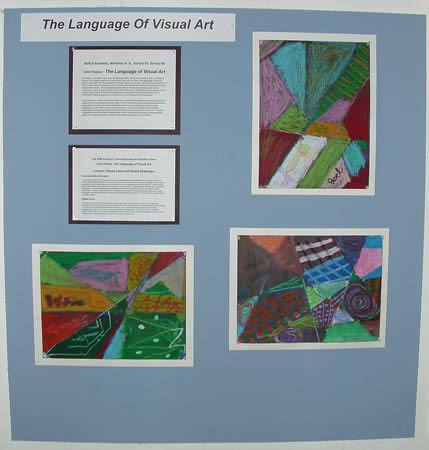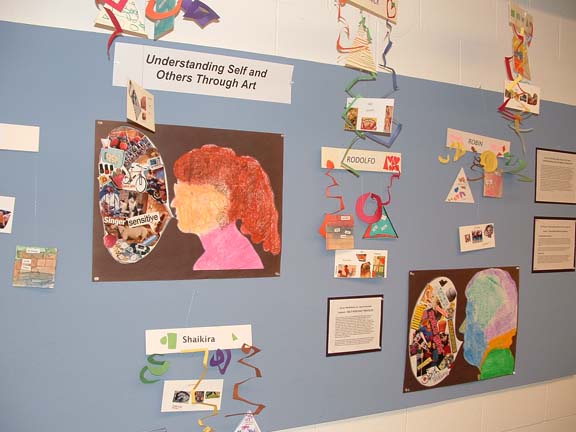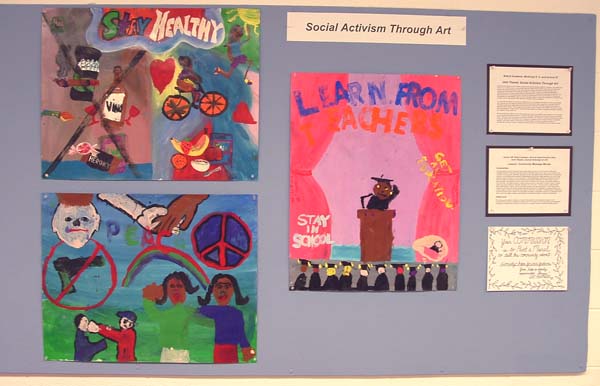10 Year Anniversary Exhibits
Unit Themes and Schools
BUILD Academy, McKinley H. S., School 57, School 68
Unit Theme: The Language of Visual Art
Click to view the lesson outlines for The Language of Visual Art unit
We begin our program each year with the idea that "every picture tells a story" and that if we are to be makers and consumers of art, then we must learn the language of art and artists. We begin with the alphabet of visual imagery as we learn about formal properties of lines, colors, shapes, textures, and how artists manipulate and compose these elements to express their ideas. This foundation equips the Art Partners for viewing, discussing, interpreting, valuing, and creating works of art effectively. Developing visual literacy in this manner also relates to life and the ability to successfully interpret and respond to the multitude of visual symbols we encounter in our environment on a daily basis.

As we explore a variety of exemplary artworks, we learn that artists are constantly telling their stories through the images that they make. The Art Partners learn to view and discuss works of art with an eye that not only deciphers the artist's use of formal properties of visual expression, but also with a mind that is engaged in an inquiry process, moving toward understanding and appreciating the artist's intention and the meaning of the work. This kind of experience sets the stage for developing critical thinking and expressive language skills, areas of learning essential to academic and personal success for our children.
Fall ’02 McKinley High School and Fall ’03 School 68
Unit Theme: The American Scene
Click to view the lesson outlines for The American Scene unit

The theme of this unit for our teens in special education and our fifth graders in an inclusion class focused on exploration of the art and cultural traditions of people of the Americas, leading up to the formation of the United States of America. We began by learning about the Native people indigenous to the eastern woodlands area of North America: the Haudenosaunee (also known as the Iroquois). Traveling west, we studied Mexican culture and created our own observance of the tradition of Dia de los Muertos (Day of the Dead) which the students shared with their entire school. Coming back east led us into an exploration of the first European settlers whose descendants were to form a new nation.
Throughout our cultural adventures we have learned to appreciate the diversity of different traditions and lifestyles, and have been inspired in our own ideas and artistic expressions. Most importantly, we have learned that people everywhere, no matter what their background, share things in common as human beings as well as artmakers. We learned that people living in the Americas hundreds of years ago had the same basic concerns we do about acquiring living skills. We also learned that every group of humans, no matter where they come from, have a natural need and urge to take things and make them special, to express themselves visually, and to give form to their inner artistic visions.
1999 BUILD Academy and 2001 School 57
Unit Theme: Appreciating My World, Visiting Different Cultures
Click to view the lesson outlines for Appreciating My World unit

It is important for all children to become aware of the larger world that exists outside of their own. In addition to enrichment, and for instilling awareness and pride in cultural identity, broadening the students’ view of our global world will enable them to become part of the vital process of working toward understanding and unity through recognition and appreciation for diversity. It is not possible for the citizens of this new millennium to live in peace and productivity without each person attaining such a view and attitude. Increasing awareness of a culture’s aesthetics productions has universal appeal and can aid in the promotion of this process.
Exploring a variety of people, cultures and their art products around the world proved to be an exciting adventure for the Art Partners as we "traveled" to Africa, Asia, Europe and our own North American continent. Through music, dance, drama and visual art, children and teachers alike had the opportunity to learn about the customs, beliefs and artistry of some of our global neighbors. For each introduction to a new culture, every attempt was made to recreate aspects of that culture through such means as examining actual artifacts, listening to authentic music, wearing traditional clothing, sampling foods, and most important, bringing in guest artists and speakers representing each culture we explored. Every lesson begins with a slide/discussion that provides an overview of major aspects of the culture under study, from lifestyles to beliefs.
As we listened to the stories and participated in the life experiences of our guests, we learned something about the lives of our own ancestors, tracing the African, European, North American and Asian roots of the children and teachers. Along the way, we discovered some important things that bring us together as we learned to appreciate difference while also beginning to see and understand more fully the natural connections among all humans.
We learned and experienced so many wonderful things including: ways in which our Native North American brothers and sisters embraced the gifts of nature in their daily lives, the chants and ritual dances of Zulu warriors, the appropriate manners used by lords and ladies attending a Medieval feast, the graceful steps and hand movements of sacred Hindu dancing, the ways in which everyday people embellished their surroundings through simple creative activities like the traditional wychinanki of the Polish and Ukraine people. We were amazed to learn that for so many world cultures, the arts are a way of life, and even the humblest of functional objects is imbued with artistry of one kind or another. We were delighted to discover that people all over the world use the same elements of line, shape, color and texture for artistic expression as we do. Perhaps best of all, the Art Partners learned how exciting the diversity in our world is, and that it is not something to be feared, but to be taught, respected, supported and celebrated.
1999 BUILD Academy and 2001 School 57
Unit Theme: Understanding Self and Others Through Art
Click to view the lesson outlines for Understanding Self and Others Through Art

To address the social development of our teens in special education, the theme of this unit centered on increasing self-awareness, learning more about the people around us, and understanding what it takes to build positive relationships. The students explored these concepts through art experiences, learning how various artists have addressed such issues in their work, and applying their own art skill and knowledge in expressing a personal response to each idea presented. We began with a focus on the self, as the students came to realize that knowing about oneself is a prerequisite to communicating and getting along well with others. Concepts of line, color, shape and texture were used to express ideas and feelings as students developed their understanding of symbolic representation in art.
Exploration of the self was followed by lessons focusing on peer interaction and communication, and finally, on the development of a loving relationship between two people. Based on the students’ expressed desires to learn more about committed love, this culminating project centered on what it takes to build a successful marriage relationship, and how artmakers have expressed ideas about this human connection in their work. In their Scene From a Marriage mural, the students have depicted an interior scene from a marriage, sharing their view of what it takes to successfully build such a relationship both in the literal as well as abstract sense.
BUILD Academy, McKinley H. S., School 57, School 68
Unit Theme: Social Activism Through Art
Click to view the lesson outlines for the Social Activism Through Art unit

When we first began the Art Partners program with second graders at BUILD Academy, we noticed that many of our children lived in economically deprived neighborhoods where resources are lacking and families work hard everyday to make ends meet and assure the welfare of their members. We understood that adverse environmental conditions can affect children’s educational experience in challenging ways, and may create a sense of helplessness, hopelessness and passive reactivity. We also knew that art is empowering and can offer an experience ripe with opportunities for developing competency and self-esteem, gaining control through mastery of media and processes, and assuming a proactive role in responding to life experience through creative expression.
To create the foundation for this kind of experience for our students, we looked to social activist artists who use their art as a means to explore, raise consciousness, teach, respond to, and take control of important social issues affecting the community and its members. We were inspired by the work of artists like Keith Haring, Faith Ringgold, Jenny Holzer, Jacob Lawrence, Ben Shahn, the Drop-Ins, and even Michelangelo, whose Sistine Chapel paintings helped the children understand the idea of reaching the masses through public art.
What we didn’t fully realize is how meaningfully even very young children would respond to the use of art as a consciousness raising tool and a means to empower themselves and others to speak out and take action. While we could not change our students’ situations, we could offer an alternative attitude and role to play as makers and consumers of art. Art gave our students a voice in ways that were unexpected, powerful, and often poignant, particularly for those students with special needs who were not accustomed to being in control or taking a proactive position of responsibility for self as well as others.
2004 Community-Based Special Education at McKinley High School
Unit Theme: Appreciating My World, Nature and the Environment
Click to view the lesson outlines for the Appreciating My World, Nature and the Environment unit

In the Art Partners program, curriculum development begins with assessment of students’ needs, review of their IEP’s (Individualized Education Program) where appropriate, and consultation with their classroom teachers to discern what particular learning goals and objectives are the focus at that time. In developing this unit, we learned that the teachers wished to design more experiences that would help the students get outside themselves to a greater extent and develop a greater sense of responsibility and empathy for others. We discussed ways to assist the students in moving away from the familiar role of one who is cared for, to one who is caretaker. We realized that this notion was very much in line with the goals of independent living as well as the spirit and intent of IDEA (Individuals with Disabilities Education Act), which is based upon the belief that including persons with special needs in the mainstream of society also means creating access to opportunities that encourage and define ways they can act as responsible, contributing members of the community like anyone else. It wasn’t hard to see that a focus on the environment, particularly nature, would be ripe with potential for creating the kinds of caring attitudes and behaviors desired.
Helping our students become better stewards of the environment would not only benefit the communities they live in, but would also offer them important personal experiences in raising consciousness, increasing self-esteem through competency, and developing a positive self-concept that includes a heightened sense of caring and empathy for the people and things in their environment. Our students began their journey with enthusiasm, moving from observers appreciating nature, toward activists in raising awareness of abuse in nature. The students’ response to this unit proved once again that we teachers must never underestimate learning potential, and must be sure to craft our pedagogy in ways that accommodate a diversity of learning differences and styles.
This is a non-commercial website and is to be used for educational or research purposes only. No commercial use is permitted without the consent of Art Partners. "Fair use" is claimed under U.S. copyright law, sections 107 and 108. For questions contact:Art Partners
©2002 Art Partners Program | All Rights Reserved